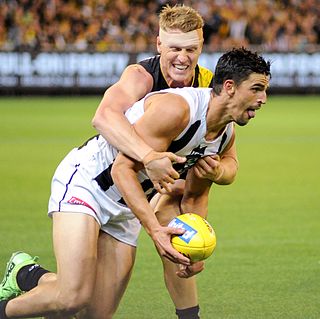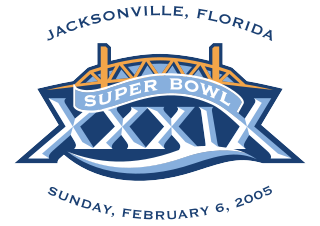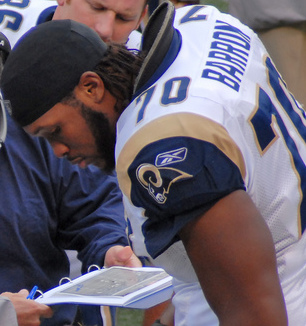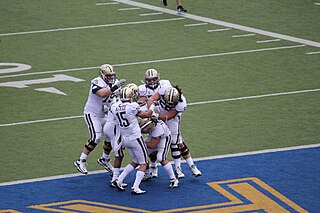
Most forms of football have a move known as a tackle. The primary purposes of tackling are to dispossess an opponent of the ball, to stop the player from gaining ground towards goal or to stop them from carrying out what they intend.
Super Bowl V was an American football game played between the American Football Conference (AFC) champion Baltimore Colts and the National Football Conference (NFC) champion Dallas Cowboys to determine the National Football League (NFL) champion for the 1970 season. It was the fifth edition of the Super Bowl and the first modern-era NFL championship game. The Colts defeated the Cowboys by the score of 16–13 on a field goal with 5 seconds left in the game. The game was played on January 17, 1971, at the Orange Bowl in Miami, Florida, and was the first Super Bowl game played on artificial turf; specifically, the game was played on a Poly-Turf surface.

A fumble in gridiron football occurs when a player who has possession and control of the ball loses it before being downed (tackled), scoring, or going out of bounds. By rule, it is any act other than passing, kicking, punting, or successful handing that results in loss of ball possession by a player.

Jeffrey Jason Garcia is an American former professional football player who was a quarterback in the National Football League (NFL). After attending high school and junior college in Gilroy, California, Garcia played college football at San Jose State University.

Terrell Eldorado Owens, nicknamed "T.O.", is an American former football wide receiver who played 15 seasons in the National Football League (NFL). Regarded as one of the greatest wide receivers of all time, Owens ranks third in NFL history in career receiving yards and receiving touchdowns.

Gridiron football, also known as North American football, or in North America as simply football, is a family of football team sports primarily played in the United States and Canada. American football, which uses 11 players, is the form played in the United States and the best known form of gridiron football worldwide, while Canadian football, which uses 12 players, predominates in Canada. Other derivative varieties include arena football, flag football and amateur games such as touch and street football. Football is played at professional, collegiate, high school, semi-professional, and amateur levels.

Super Bowl XXXIX was an American football game played between the American Football Conference (AFC) champion New England Patriots and the National Football Conference (NFC) champion Philadelphia Eagles to decide the National Football League (NFL) champion for the 2004 season. The Patriots defeated the Eagles by the score of 24–21. The game was played on February 6, 2005, at Alltel Stadium in Jacksonville, Florida, the first time the Super Bowl was played in that city.

Musa Smith is a former American football running back who played five seasons in the National Football League (NFL). He was drafted by the Baltimore Ravens in the third round of the 2003 NFL Draft. Smith has also been a member of the New York Jets. He played college football at Georgia.

Alex Benjamin Barron is a former American football offensive tackle in the National Football League (NFL) for the St. Louis Rams, Dallas Cowboys and New Orleans Saints. He was drafted by the St. Louis Rams with the 19th overall pick of the 2005 NFL Draft. He played college football for Florida State University, and was a two-time consensus All-American.
The 2005 NFL season was the 86th regular season of the National Football League (NFL).

Roy Lee Williams, is an American former professional football player who was a safety in the National Football League (NFL) for nine seasons. He played college football for the Oklahoma Sooners, earning unanimous All-American honors. He was selected by the Dallas Cowboys eighth overall in the 2002 NFL Draft, and played professionally for the Cowboys and Cincinnati Bengals. He earned five straight Pro Bowl selections from 2003 to 2007. Williams was considered by some to be of the most violent hitters in football during his playing career, and sometimes received criticism for his perceived “dirty” play-style. Williams is currently a sideline reporter for Oklahoma football games.
Cedric Laquon Killings was an American professional football player who was a defensive tackle in the National Football League (NFL). He was originally signed by the San Francisco 49ers as an undrafted free agent in 2000. He played college football at Carson–Newman University.
Robert Lee Geathers, Jr. is a former American football defensive end. He played college football at the University of Georgia. He was selected by the Bengals in the fourth round of the 2004 NFL Draft.

A comparison of American football and rugby union is possible because of the games' shared origins, despite their dissimilarities.

In gridiron football, touchdown celebrations are sometimes performed after the scoring of a touchdown. Individual celebrations have become increasingly complex over time, from simple "spiking" of the football in decades past to the elaborately choreographed displays of the current era.

High school football, also known as prep football, is gridiron football played by high school teams in the United States and Canada. It ranks among the most popular interscholastic sports in both countries, but its popularity is declining, partly due to risk of injury, particularly concussions. According to The Washington Post, between 2009 and 2019, participation in high school football declined by 9.1%. It is the basic level or step of tackle football.

The Cowboys–Eagles rivalry is a 63 year-long intra-divisional rivalry between the Dallas Cowboys and Philadelphia Eagles of the National Football League (NFL), with the two teams contained in the same division since 1961.
In American football, an unfair act is a foul that can be called when a player or team commits a flagrant and obviously illegal act that has a major impact on the game, and from which, if additional penalties were not enforced, the offending team would gain an advantage.

Helmet-to-helmet collisions are occurrences in gridiron football when two players' football helmets make head-to-head contact with a high degree of force. Intentionally causing a helmet-to-helmet collision is a penalty in most football leagues, including many high school leagues.














